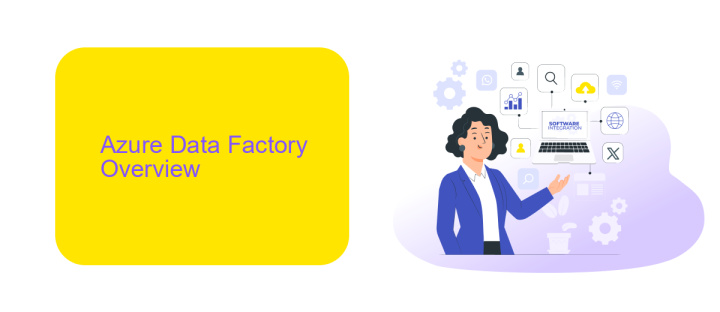What is the Difference Between Azure Synapse and Azure Data Factory
Azure Synapse and Azure Data Factory are both integral components of Microsoft's cloud ecosystem, designed to handle vast amounts of data. While they share some similarities, they serve distinct purposes. Azure Synapse focuses on data analytics and warehousing, offering powerful tools for big data and machine learning. In contrast, Azure Data Factory excels in data integration and orchestration, enabling seamless data movement and transformation.
Azure Synapse Analytics Overview
Azure Synapse Analytics is a comprehensive analytics service that brings together big data and data warehousing. It offers a unified experience to ingest, prepare, manage, and serve data for immediate business intelligence and machine learning needs. Synapse allows for seamless integration with other Azure services, providing a robust ecosystem for data professionals.
- Unified analytics platform for big data and data warehousing
- Seamless integration with Azure services
- Real-time data processing and analytics
- End-to-end data management and governance
One of the key features of Azure Synapse is its ability to integrate with various data sources and services, enhancing its flexibility and usability. For example, ApiX-Drive can be used to streamline data integration processes, allowing for automated workflows and real-time data synchronization across different platforms. This makes Azure Synapse an ideal choice for organizations looking to leverage their data for advanced analytics and decision-making.
Azure Data Factory Overview

Azure Data Factory (ADF) is a cloud-based data integration service that allows you to create data-driven workflows for orchestrating and automating data movement and data transformation. With ADF, you can construct complex ETL (Extract, Transform, Load) processes that scale to the cloud, enabling you to ingest data from multiple sources, transform it into meaningful insights, and load it into various destinations for further analysis. The service supports a wide range of data sources, including on-premises and cloud-based databases, file systems, and SaaS applications.
ADF provides a rich set of features for managing data workflows, including scheduling, monitoring, and debugging capabilities. It integrates seamlessly with other Azure services, such as Azure Synapse Analytics, Azure Databricks, and Azure Machine Learning, to provide a comprehensive data solution. Additionally, for those looking to simplify the integration process, services like ApiX-Drive can be utilized to connect various applications and automate data flows without the need for extensive coding. This makes ADF a versatile tool for data engineers and analysts aiming to streamline their data pipelines and enhance their data management strategies.
Comparison of Features

When comparing Azure Synapse and Azure Data Factory, it's essential to understand their unique features and capabilities, as both services cater to different aspects of data management and analytics.
- Data Integration: Azure Data Factory is primarily designed for data integration and ETL (Extract, Transform, Load) processes, allowing users to create data pipelines from various sources to destinations. Azure Synapse, on the other hand, integrates with multiple data sources for comprehensive analytics but focuses on data warehousing and big data analytics.
- Analytics: Azure Synapse offers advanced analytics capabilities, including SQL analytics, big data analytics, and integrated Spark and SQL engines. Azure Data Factory lacks these in-built analytics tools but can orchestrate data movement and transformation to feed analytics platforms.
- Integration Services: While both services support integration, Azure Data Factory excels in orchestrating complex workflows and scheduling data pipelines. Azure Synapse provides a unified environment for data integration, warehousing, and analytics.
In summary, Azure Synapse is a more comprehensive solution for data warehousing and analytics, while Azure Data Factory specializes in data integration and ETL processes. For seamless integration and automation, tools like ApiX-Drive can be utilized to enhance data workflows across both platforms.
Choosing the Right Service

When deciding between Azure Synapse and Azure Data Factory, it's crucial to understand the specific needs of your project. Azure Synapse is ideal for complex analytics and big data solutions, providing a unified experience for data integration, warehousing, and big data analytics. On the other hand, Azure Data Factory excels in orchestrating data workflows and transforming data at scale.
Consider the following factors to make an informed decision:
- Data Volume: Choose Azure Synapse for handling large volumes of data with advanced analytics.
- Workflow Orchestration: Opt for Azure Data Factory if your primary need is to automate and manage data workflows.
- Integration Needs: Use Azure Data Factory for seamless integration with various data sources and services like ApiX-Drive.
- Cost: Analyze your budget, as Azure Synapse might be more costly due to its comprehensive features.
Ultimately, the choice depends on your specific requirements and goals. For projects requiring extensive data integration and workflow automation, leveraging tools like Azure Data Factory in conjunction with ApiX-Drive can streamline your processes effectively. For more complex analytical tasks, Azure Synapse offers a robust solution.
Conclusion
In conclusion, both Azure Synapse and Azure Data Factory offer robust solutions for data integration and analytics, but they serve different primary functions. Azure Synapse is an integrated analytics service that accelerates time to insight across data warehouses and big data systems. It is ideal for complex, large-scale data processing and analytics tasks, providing a unified experience to ingest, prepare, manage, and serve data for immediate business intelligence and machine learning needs.
On the other hand, Azure Data Factory is a cloud-based data integration service that allows you to create data-driven workflows for orchestrating and automating data movement and data transformation. It excels in ETL (Extract, Transform, Load) processes and is designed to handle data from various sources and formats. For those looking to streamline integrations further, services like ApiX-Drive can be instrumental. ApiX-Drive simplifies the process of connecting various applications and automating data workflows, ensuring seamless integration between disparate systems. Choosing between Azure Synapse and Azure Data Factory ultimately depends on your specific data needs and business objectives.
FAQ
What is the primary purpose of Azure Synapse?
What is the primary purpose of Azure Data Factory?
Can Azure Synapse and Azure Data Factory be used together?
What are the main differences in terms of data transformation capabilities between Azure Synapse and Azure Data Factory?
How can I automate data integration and transformation tasks between various services?
Apix-Drive is a universal tool that will quickly streamline any workflow, freeing you from routine and possible financial losses. Try ApiX-Drive in action and see how useful it is for you personally. In the meantime, when you are setting up connections between systems, think about where you are investing your free time, because now you will have much more of it.

